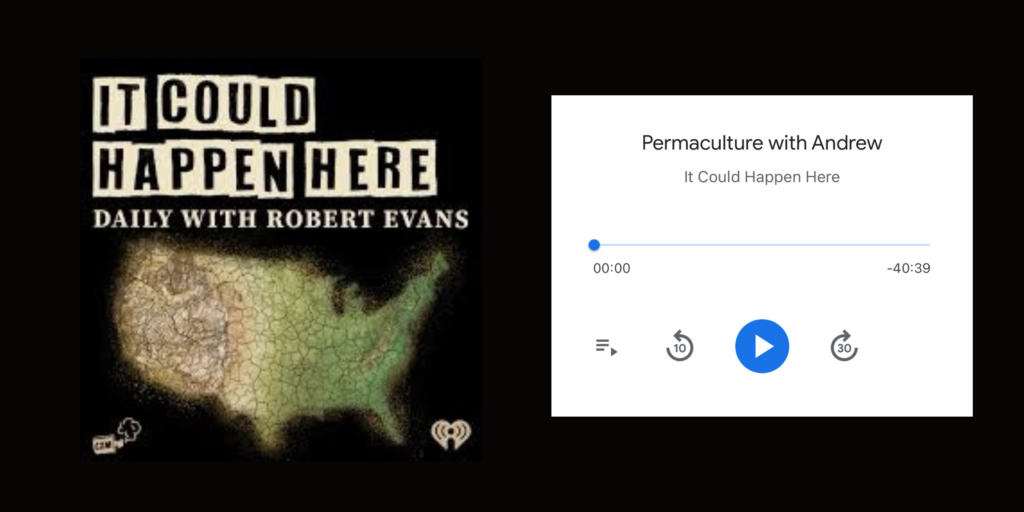It Could Happen Here Podcast – Permaculture with Andrew
September 5, 2022 • 38 min
Andrew explains the principles of permaculture to Chris and James
Permaculture with Andrew (on Youtube as Andrewism)

- Ways that we can enhance our food autonomy
- Permaculture was first coined in the 70s as a portmanteau (permanent + agriculture)
- Has already existed for thousands of years with indigenous groups all over the world
- Bill Morrison has given it a spin for a modern audience
- All biological material is a potential energy source
- Circular economies and cycles
Ethics focused CARE FOR
- Earth – all living and nonliving things
- All people – promoting self reliance and community responsibility. We all have access to the resources necessary for existence
- Community. Allows us to think of an approach our society in a way that benefits all people and all life. Not just neighbors or people who live in our city/town. All the things that incorporate our surroundings and beyond
Anybody can take part in permaculture design. Basic principles can be established in all circumstances
- Recognition of connection to a location.
- Web is stronger than a single string. All these parts create something stronger than individuals moving by themselves
- Connection between waste & resources – when it comes to ecosystems take this literally
- Waste of one part of system directly feeds into the resource of another part
- Eg decomposition feeding into fungal network and flourishing of next generation of plants & animal
- Get external sources especially at beginning while you’re establishing the system. Aim is to have system continuously establishing, expanding and maintaining itself
- Each element performs multiple functions.
- Example – Wasamaki Ecosystems
- https://www.wasamakipermaculture.org
- Regenerating the land from a sand mine using banana trees
- When there is a system out of balance, nature gives a warning. Such as pests. (“Optimizers”) Certain amount of a pest in a system indicates something is wrong with that system. System imbalance doesn’t have the mechanisms in place to keep the optimizers in check
- Eg reintroducting wolves stabilizing entire park ecosystems.
- How Wolves Change Rivers – George Monbiot
- Each function supported by multiple elements.
- Don’t have just one source. Grow a mix of trees, cultivars, species, etc. that make up an actual forest
- Food forest
- 7 levels of beneficial system
- Top – canopy (fruit and nut trees) keep climate stable
- 2nd – dwarf fruit trees
- 3rd – shrub- berries and smaller plant
- 4th – herbaceous – herbs & spices
- 5th – root vegetables
- 6th – ground cover – soil surface crops- protects soil
- 7th – vertical – climbers & vines
- Water – not all from same source (eg pipes)
- Use rain, water table, stream, – ways to trap that water
- Aim is to water itself
REDUNDANCY IS VERY IMPORTANT
REDUNDANCY IS VERY IMPORTANT
REDUNDANCY IS VERY IMPORTANT
- Approach permaculture with energy efficiency in mind
- Practically speaking, do a zoning sector analysis to determine patterns (rain, flood, fire, pollution, noise, sunshine, wind). Harness energies and plant accordingly to optimize.
- Use zones, e.g.: living space, kitchen/garden, consumption/processing, community support & surplus
- Use of biological resources
- Natural insecticides, nitrogen fixers
- Natural evolution already fulfill those roles, so use them to fulfill these roles
- Eg bats for insect
- Three sisters companion planting
- Practice of energy cycling
- Make most of organic matter so it produces no real waste
- Most Trap sunlight
- Incorporate elements in smaller scale
- Aquaculture system, planter beds
- Natural plant successions and stack
- Continual production
- Short term and long term.
- Layers in place
- Diversity. Poly culture
- Pay attention to edge within a system. Unique niches that allow for more rare and vulnerable corners of life.
- Observe natural patterns. Spirals, waves, branches. Repeating patterns. Seasons. Weather.
- “I think that’s something that more people need to recognize about humanity. We didn’t just spring onto like some sort of alien parasite leeching off of the earth. We- just like every other animals, like every other creature on this planet- have a role to play in the ecosystems we inhabit. Unfortunately a lot of that activity has been destructive because of how our socioeconomic system has been structured. But that’s something we have a role in changing. Part of that is recognizing that we are stewards- we can have good stewards. We can help to facilitate the flourishing of life. We don’t have to be grim reapers upon the systems we are a part of.”
- Pay attention to the scale of the systems. Recognize it’s long term. Establish over generations.
- Be positive
- Experiment
- Learn from mistakes
- Get more community involved in imagining complex, beautiful revolutionary project